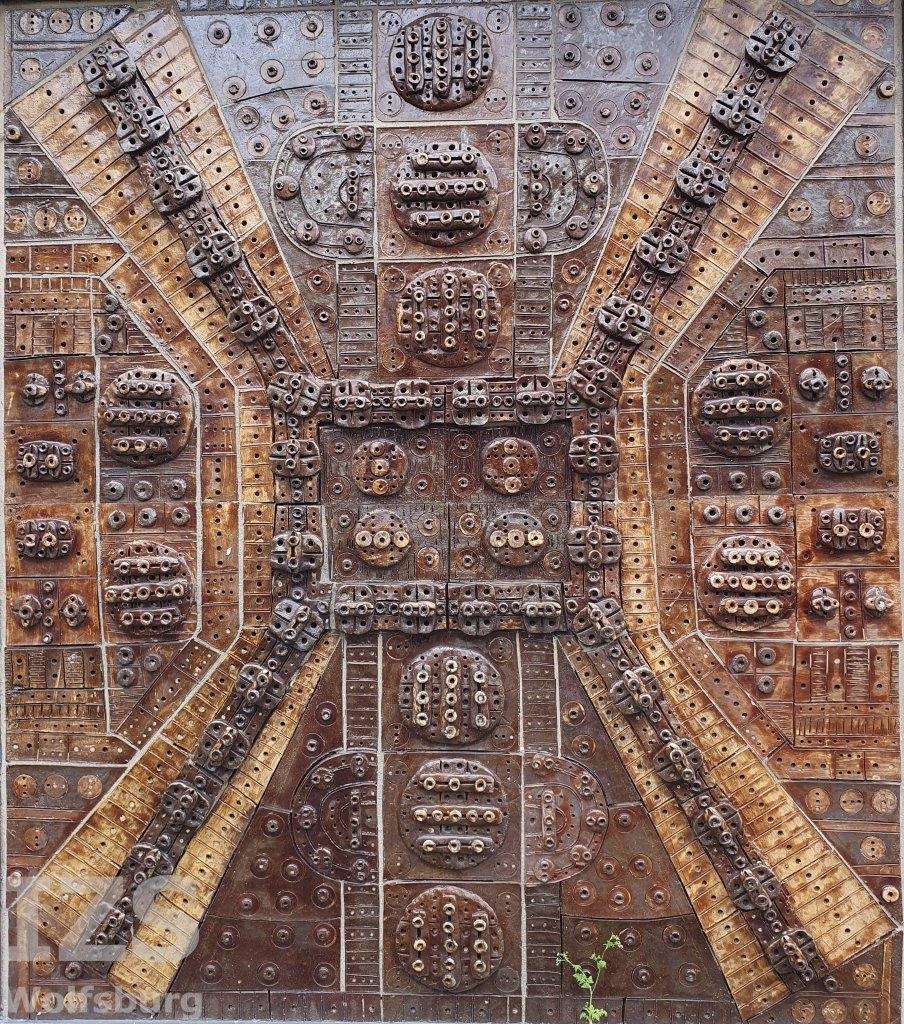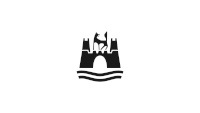Wall reliefs, Rudolf Mauke (1970)
From Maik Ullmann
When the architect Rudolf Richard Gerdes was commissioned to build the Detmerode elementary school center, today's Bunte Grundschule, in the late 1960s, he was given the explicit task of contacting the Schloßstraße 8 artists' group to discuss the artistic design of the school. This is not surprising in that so-called art in architecture has become more important in larger building projects since the beginning of this decade. Individual artists from the collective based in the castle had also previously been able to permanently install their works at various Wolfsburg schools.
The group, which in addition to Rudolf Mauke (Fig. 1) also included Heinrich Heidersberger, Paul-Kurt Bartzsch and Gustav Kurt Beck, for example, had repeatedly received commissions directly from the city council during the heyday of their work - a practice that has since been criticized. There was talk of 'cobbling together' design fees. However, it is not clear from the files who made these allegations of corruption.-__-0000-__- The city council then decided to refrain from commissioning its 'Haus und Hof' artists directly as a group and without a public tender. The reason for the rethink was the artistic design in the Detmerode elementary school center.

City councillor Karl-Heinz Schulte informed the architect in a letter dated December 9, 1969 that Gerdes should contact the spokesman of the Schloßstraße 8 artists' collective, Hans Schönfeld, "as agreed" in order to discuss everything else with him. For the first time, the artists' group was specifically invited by the city council to submit various designs for "Kunst am Bau".-__-0001-__- In the end, Rudolf Mauke was able to win over the art advisory board and the jury in the culture committee with a design representative of his artistic work - ceramic reliefs. But what exactly was it all about? A wall in the foyer of the school's youth recreation area was to be designed by the group based in Wolfsburg Castle. Helga Pape, Gustav Kurt Beck, Heinrich Heidersberger, Jürgen Siems, Jochen Kramer and Hans Schönfeld submitted designs, as did Rudolf Mauke. -__-0002-__- The latter had already decorated a connecting corridor of the same school with ceramic reliefs two years earlier.-__-0003-__- In the spring of 1970, a letter from the building department officially stated: "The group 'Schlossstraße 8' -__-0004-__- is commissioned to produce several designs for the artistic decoration of the Detmerode elementary school center in coordination with the architect, Dr.-Ing. R. R. Gerdes, for a design fee of DM 3,000." -__-0005-__- - A procedure that was tantamount to 'coughing up' fees.
The group had no shortage of ideas. After just a few months, it presented six drafts that were not described further in the files. The Art Advisory Board, a body set up specifically to advise the administration on art issues, met in May 1970 to make its recommendation. The members were not convinced by Pappe's, Beck's and Heidersberger's designs, but there were no objections to Rudolf Mauke's. The submissions by Siems and Kramer were in the spotlight. In the end, however, Mauke was awarded the contract to create two ceramic wall reliefs, as stated in a letter from the Education and Culture Department:
"The artist Rudolf Mauke has already executed -__-0006-__- ceramic reliefs on the existing connecting corridor in the school center in 1968. The designs now submitted for -__-0007-__- further ceramic reliefs are related to these works. The Art Advisory Board has not raised any objections to this.Thecosts for the design and execution amount to DM 9,500."-__-0008-__-
The square objects, in brown earth tones and fired from clay, measure 2.35 meters by 2.05 meters (Fig. 2). Visually, they are strikingly similar to the three reliefs that Mauke had already placed on the building two years earlier. They are thus in keeping with his oeuvre as a whole and are typical of his sculptural work.

An x-shaped body divides the relief into four sections, which nestle against the edges of the picture on the right and left as well as at the top and bottom. There is also a rectangular section in the center of the ceramic. Within these sections, the artist arranges geometric shapes: Circles, rectangles, squares and ellipses. Triangles can be found in the corners of the picture. The relief looks like a mechanical construct: each element seems to be placed in a specific position to hold the body together. A composition of eyelets, washers, buttons and hinges that interlock like a music box. The artist himself described the sculpture at the time as a "surface-related constructive as well as kinetically and serially tangible formation" (Fig. 3).-__-0000-__-

Mauke's work had already received much encouragement from the administration in the past. He himself had only been lured to Wolfsburg in 1964 at the request of the then Lord Mayor Hugo Bork.__-0000-__- His subsequent works in Wolfsburg's hospital, a 5.5 meter by 3 meter wall relief, or a vase set up in Wolfsburg Castle, seem relatively small in comparison to his works, which he created in large format on 32 square meters for the World Exhibitions in Brussels (1959) and the Berlin Pavilion in New York (1964), but they are true treasures in Wolfsburg's cityscape, especially against this background.
Sources
-__-0000-__- IZS Wolfsburg, ref. 41 51, Kunst im Stadtbild, Schul- und Kulturamt, memo, conversation with the group "Schlossstraße 8", August 17, 1970.
-__-0001-__- IZS Wolfsburg, ref. 41 51, Kunst im Stadtbild, Schulte to Gerdes, December 9, 1969.
-__-0002-__- "Relief and 'kinetics'. Kunstbeirat, Kulturausschuß und Schloßstraße 8 gebühren Dank", in: Wolfsburger Allgemeine Zeitung of August 26, 1970.
-__-0003-__- IZS Wolfsburg, Az. 41 51, Kunst im Stadtbild, "Schlossstraße 8" to Gerdes, March 3, 1970.
-__-0004-__- IZS Wolfsburg, ref. 41 51, Kunst im Stadtbild, Künstler L-M, Schul- und Kulturamt an den Kulturausschuss, Bauausschuss und Verwaltungsausschuss, Kunst am Bau of March 19, 1968.
-__-0005-__- IZS Wolfsburg, ref. 41 51, Kunst im Stadtbild, Schul- und Kulturamt an das Hochbauamt dated March 24, 1970.
-__-0006-__- IZS Wolfsburg, ref. 41 51, Kunst im Stadtbild, Schul- und Kulturamt an den Kulturausschuss vom 27. May 1970.
-__-0007-__- IZS Wolfsburg, ref. 41 51, Kunst im Stadtbild, undated description of Mauke's reliefs.
-__-0008-__- Helmut Raabe, "Informationstext über Rudolf Mauke", in: Kulturbüro Wolfsburg (ed.), Künstlergruppe Schloßstraße 8. Wolfsburg 2007, p. 26f.
